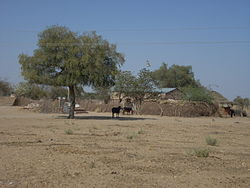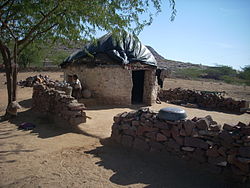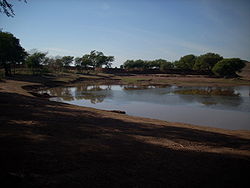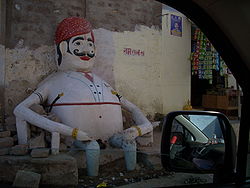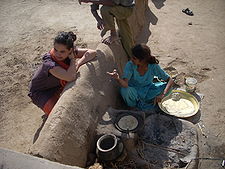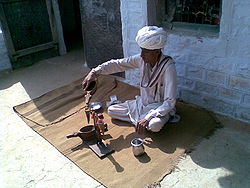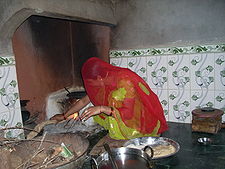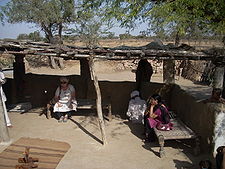- Dhani and villages
-
- For the Indonesian air marshal, see Omar Dhani.
This article describes the usual characteristics of dhani and villages, particularly as found in Rajasthan.
Contents
What is Dhani?
In North-West India, a dhani [1] is the smallest conglomeration of huts. All families living in a Dhani are relatives of each other or at least are of the same caste. Most Indian villages are small; nearly 80 percent have fewer than 1,000 inhabitants, according to the census of India 2001. Most are nucleated settlements, while others are more dispersed. It is in villages that India's most basic business—agriculture—takes place.
For a tourist visiting Rajasthan for the first time, it is actually difficult to find a village in the vast stretches of barren land. It is only when a herd of cattle is seen around that the tourist gets an inkling of a village nearby.
Dhanis are ancillaries to the village. Those who want to live in proximity to their fields make their huts in the field and are able to take care of their crop in a better way. The crop when ready is a valuable asset and needs to be properly guarded from stray animals and enemies.
A dhani is a complex socio-economic unit.[2] According to the Revenue Act,[3] in India this is smallest viable unit. A cluster of a few houses is known as “Dhani” in Rajasthan. Indian villages are definitely simple. A cluster of mud-plastered walls shaded by a few trees, set among a stretch of green or dun-colored fields, men sitting under some old tree smoking bidis with fellow villagers of their own age group, ladies with veiled faces moving towards the central well to fetch water, cattle making many types of noises, children playing typical village games like gulli-danda and satoliya—all present an image of eternally peaceful bliss and harmony.
Indian city dwellers often refer nostalgically to their native village and how they miss that life but soon are taken back by absurdly hectic city life. City artists portray colorfully garbed village women gracefully carrying water pots on their heads, and writers describe isolated rural settlements unsullied by the complexities of modern urban civilization. Poets including Indian National Poet Maithili Sharan Gupt have written poems in praise of village life. Social scientists of the past wrote of Indian villages as virtually self-sufficient communities with few ties to the outside world.[4]
Since all marriages are done in the same or nearby village, villagers in India manifest a deep loyalty to their village, identifying themselves to strangers as residents of a particular village, harking back to family residence in the village that typically extends into the distant past. A family rooted in a particular village does not easily move to another, and even people who have lived in a city for a generation or two refer to their ancestral village as "our village." Even business communities who have shifted to far-off places for business activities like traders from Rajasthan in Culcutta, Chennai and Assam make it a point to visit their native village for performing social ceremonies.
No matter how strong the bond of the villagers is, their unity is challenged by a lot of conflicts, rivalries, and factionalism. Disputes, strategic contests and even violence occur. Most villages of India include prosperous, powerful people, who are fed and serviced through the labors of the lower-class people. Due to the expanding government influence in rural areas and increased pressure on land and resources, the populations are sto;; a target of factionalism and competitiveness in many parts of rural India.
Village buildings
Village life in Rajasthan has a rich cultural heritage.[5] Rajasthan has variety of village life depending on topography, history, caste system and traditional festivals like cattle fairs, Haat and religious fairs. The village dwelling unit popularly known as a hut is usually circular in shape. Its simplest hamlets, the most basic form of civilisation with a way of life that has probably remained unchanged since centuries, consist of a collection of huts that are circular, and have thatched roofs. The walls are covered with a plaster of clay, cow dung, and hay, making a termite-free (antiseptic) facade that blends in with the sand of the countryside around it. It is thatched with grass and haysticks. Sometimes clay moulded Kelu are also used. Boundaries for houses and land holdings, called baras, are made of the dry branches of a nettle-like shrub, the long, sharp thorns a deterrent for straying cattle. The huts so made are technically hygienic and give the feeling of air conditioning. In summers they remain cool and in winters it remain warm. If a dhani looks bleak, it is hardly surprising: the resources for building these homes, which are the most eco-friendly living unit, are made with what is available at hand, and in Rajasthan, and particularly so in its western desert regions, this can mean precious little. A village that is even a little larger may have pucca houses, or larger living units, usually belonging to the village Zamindar family. Consisting of courtyards, and a large Nora or cattle enclosure, attached to one side or at the entrance, these are made of a mixture of sun-baked clay bricks covered with a plaster of lime.
Common village structures
Indian villagers share use of common village facilities—the village pond (known in India as a tank), grazing grounds, temples and shrines, cremation grounds, schools, sitting spaces under large shade trees, wells, and wastelands. Every village has a pond where cattle and children bathe and play. It is a romantic place where youngsters get a chance to steal a glimpose of their beloved. Outside the village or in the center a temple is must in every village. Near the pond there is always a shiva temple with a Lingum where mostly young girls offer water and pray for a good husband.
Village religion
A great many observances emphasize village unity. Typically, each village recognizes a deity deemed the village protector or protectress, and villagers unite in regular worship of this deity, considered essential to village prosperity.They may cooperate in constructing temples and shrines important to the village as a whole. Hindu festivals such as Holi, Dipavali (Diwali), and Durga Puja bring villagers together. A woman born in a village in India is known as a daughter of the village, while an in-married bride is considered a daughter-in-law of the village.
Local deities
Every region of India worships some local deity. In Rajasthan, Baba Ramdevji, Pabuji, Hadpuji, Eloji and Gogaji are highly revered and worshipped. On certain dates related to them fairs are held and thousands of villagers pay their homage to that deity.
Transport in and between villages
Bullock cart or camel cart are still used in villages as means of transport. For travelling to nearby villages, buses and jeeps, tractors are more popular. All villages are now connected with roads which may be pucca, i.e. made of coal tar or kuchha, i.e. made of gravel only. Most of the roads in the interior villages are motorable and have at least one government approved bus service. Each village is connected through a variety of crucial horizontal linkages with other villages and with urban areas both near and far.But there is a place which horizons₦
Caste system
The layout of a village is based on caste. The working class people mostly live on periphery of village and do not have access to public wells. Indian village dwellings are built very close to one another in a nucleated settlement, with small lanes for passage of people and sometimes carts. Village fields surround the settlement and are generally within easy walking distance. In the deserts of Rajasthan villages are far and apart and located where the probability of water was high.
A village is a multi-community settlement, the various castes creating a structure of dependence based on the nature of their work. Changes are being wrought in this structure, with ceilings on land holdings, and with the young seeking employment opportunities in towns distant from their villages.
Most villages are characterized by a multiplicity of economic, caste, kinship, occupational, and even religious groups linked vertically within each settlement. The caste system plays a key role in all types of activities. In one of the first of the modern anthropological studies of Indian Dhani life, anthropologist Oscar Lewis called this complexity rural cosmopolitanism. It has a web of life where all are linked and depend on each other for survival.
Usually there is one caste that dominates the village; some villages are dominated by Rajput (warriors), Gurjar (warrior),[6] Jat (warrior now agriculturist), Muslim, Vishnoi (environmentalist), Kumhar (potter), Meghwal (weaver), or Brahmins. The number of castes resident in a single village can vary widely, from one to more than forty. Typically, a village is dominated by one or a very few castes that essentially control the village land and on whose patronage members of weaker groups must rely.
There are sub castes within castes. Subcastes like washer man, sweeper, cobbler, barber, laborers, weavers, are not untouchables. Only a few like sweepers and drum beaters are untouchables. Tea at a tea shop in villages is offered in separate cups to them and they wash it themselves.
Work
All villagers have some type of skill to generate money in case of drought. Also, the basic needs of villagers are fulfilled by local craftsmen who are for many generations engaged in a particular trade, such as tailor, grocer, priest or pundit, carpenter, blacksmith, barber, weaver, potter, leather workers, street sweeper, waterbearers, and so on. The craftsmen make artistic things: even a bullock cart may have many carving and improvisation depending on the imagination of artisan. Village religious observances and weddings are occasions for members of various castes to provide customary ritual goods and services in order for the events to proceed according to proper tradition. The artisans of some villages make handicrafts[7] items that are in high demand in big cities for decorative purposes.
In villages, some professions are strictly traditional, while a few others have been adopted by people with a pragmatic approach. Aside from caste-associated occupations, villages often include people who practice nontraditional occupations. For example, Brahmans or Thakurs may be shopkeepers, teachers, truckers, or clerks, in addition to their caste-associated occupations of priest and farmer. Villagers may move to other places in search of better opportunities but never forget their roots. In villages near urban areas, an increasing number of people commute to the cities to take up jobs, and many migrate. Some migrants leave their families in the village and go to the cities to work for months at a time.
At slack seasons, village life in India can appear to be sleepy, but usually villages are humming with activity. The work ethic is strong, with little time out for relaxation, except for numerous divinely sanctioned festivals and rite-of-passage celebrations. Residents are quick to judge each other, and improper work or social habits receive strong criticism. Indian villagers feel a sense of village pride and honor, and the reputation of a village depends upon the behavior of all of its residents.
Camels and buffaloes are used for pulling the plough, and most of the farmers wait for the rains to water their fields. Three important crops grown in Rajasthan are wheat, corn and millet. Lentils, cotton and spices are also important cash crops. Work like plowing or harvesting is done on cooperative basis.
Village judicial system
Villages in India have their own judicial system.[8] All disputes pertaining to land, marriages, cattle, loans and social obligations were solved by headmen, sometimes known as sarpanch. This judicial body is made up of five persons who are responsible for maintaining law and order in the village. The panchayat was composed of important men from the village's major castes, who had the power to levy fines and exclude transgressors from village social life. Disputes were decided within the village precincts as much as possible, with infrequent recourse to the police or court system. The Indian government supports an elective panchayat and headman system, which is distinct from the traditional council and headman, and, in many instances, even includes women and very low-caste members. As older systems of authority are challenged, villagers are less reluctant to take disputes to court. The justice was prompt and more practical. The villagers are either having their own field to plow or work as laborers in the field of land owners.The class of exploiters and exploited are eternally there. The disputes are amicably settled and rarely police or courts are approached by villagers.
Food
Pearl millet is the staple food of Rajasthan. The principal meal for the village family consists of dinner, when freshly baked bread and porridge is served with a yoghurt curry called curry, and with vegetables that may consist of dried beans, or, now, increasingly, fresh produce that is grown and transported from neighbouring states. For most families, breakfast is a glass of hot tea gulped down with stale bread, and lunch is a frugal meal of unleavened bread known as sogra eaten with a spicy chutney of chillies and garlic.The Gurjars and Jats are vegetarians mostly. Rajputs and some worker classes are not vegetarians. In the villages they rear hens for chicken meat. However, most meals are vegetarian, and although they eat meat, the Rajputs do not consume it regularly. In the old days, game would be hunted, and the spoils shared with families in the village. With the ban on hunting, meat now comes from goats raised in the communities, but they are slaughtered only for special occasions like marriages, festivals and celebrations.
Use of drugs and stimulants
Use of opium, tadi, country liquor, gambling and ganja is not looked down on by society and has some sort of social acceptance, especially on festivals like Holi or ceremonies like marriage.
Opium is the most popular form of intoxication in Rajasthan. A large number of villagers are growing opium in their fields under the license of Government. There are outlets selling Bhang, opium and doda (dried poppy flower). Many nongovernmental organizations are working for de-addiction but with little success. This has its root in distant past in certain communities like Bishnoi and is part of all social rituals to the extent that if opium is offered and is refused it is considered as personal insult.
Village Tourism
In the big cities of India the soul of Indian culture is vanishing rapidly. Hence the concept of Village Cot Surfing was created by Vipin Goyal which is getting popular amongst foreign and Indian tourists.
Villages offering Cots
- Beda
- Kakani
- Salawas
- Bilada
- Sathin
- Gangani
- Khichan
- Satlana
- Guda Bishnoi
- Khejarla
- Sirdon
- Indolav
- Kherapa
- Zhalamand
- Jambo
- Mogra
- Birami
- Singhasni
- Lolawas
- Kakelao
- Kheevsar
- Dhoro Ki Dhaani
- Badli
- Bawdi
- Ghadav
- Rohat
- Kakani
- Luni
External links
- Indian Environmental portal
- About Rajasthan
- District Level Availability Index
- Women education
- Transport to Villages
- Travel in Rajasthan
- Bishnoi
- How a 50 day internship stint in a Rajasthan village is for a student of rural management
- Wikitravel on Rajasthan
- Bishnoi
- Rajasthan Tourism Development Corporation
- Village Cot Surfing
- Rural India
- Gandhi and villages
Notes
- ^ Sukhvir Singh Gahlot: Rural Life in Rajasthan, page 4.Rajasthani Granthagar, Giani Press Delhi 1986
- ^ Katar Singh: Rural Development Principles, Policies and Management, Introduction. age Publication, London 1986
- ^ Moti Lal Jain: The Rajasthan tenancy act, 1955,.Ajmer : Kanoon Saptahik Publications, 1975.
- ^ Ramanlal Shah: Jeevan Ek Kala, Manak Magazine Page 68.Manak Prakashan December 1988
- ^ G.N. Sharma: Social Life in Medieval Rajasthan (Agra, 1969)
- ^ Singh, Kumar Suresh (1998). Rajasthan, Volume 2 Volume 38 of People of India. Popular Prakashan. pp. 180. ISBN 8171547664,ISBN 9788171547661. http://books.google.co.in/books?id=iKsqzB4P1ioC&pg=PA180&dq=Rajasthan,+By+Kumar+Suresh+Singh+Kumar+rajput+and+other+warrior+communities&as_brr=3#v=onepage&q=&f=false. "The bopa claim to rajput ancestory and hence their status is equivalent to Kshatriya varna.Rajput and other warrior communities like Gurjar and jat do not accept them as their equals"
- ^ H. Bhisham Pal: Handicrafts of Rajasthan, Page 1-65. Publication Division Ministry of Information and Broadcasting Government of India, 1984
- ^ Douglas Ensminger: Rural India in transition, page 48. All India Panchayat Parishad 1972
Categories:- Rajasthani culture
- Populated places in India
Wikimedia Foundation. 2010.

